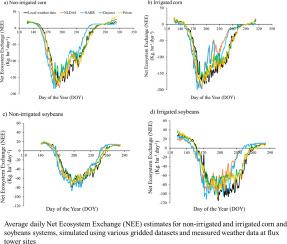Agricultural Systems ( IF 6.6 ) Pub Date : 2021-12-04 , DOI: 10.1016/j.agsy.2021.103341 Varaprasad Bandaru 1

|
CONTEXT
Net carbon balance on croplands depends on numerous factors (e.g., crop type, soil, climate) and their interactions. Agroecosystem models are generally used to assess cropland carbon fluxes because of their ability to capture the complex interactive effects of factors influencing carbon balance. For regional carbon flux simulations, generally gridded climate data sets are used because they offer data for each grid cell of the region of interest. However, studies consistently report uncertainties in climate datasets, which affect the accuracy of carbon flux simulations.
OBJECTIVE
The objectives were to 1) determine the uncertainties in daily weather variables of commonly used high resolution gridded climate datasets in the U.S (NARR, NLDAS, Prism and Daymet); 2) estimate their impact on the accuracy of simulated Net Ecosystem Exchange (NEE) under irrigated and non-irrigated corn and soybeans using the Environmental Policy Integrated Climate (EPIC) agroecosystem model, and 3) understand the relative sensitivity of the NEE to various climate variables.
METHODS
The observational data at four flux tower cropland sites in the U.S Midwest region were used to quantify the uncertainties in the gridded weather datasets, and EPIC simulations were performed at each flux tower site using each gridded climate dataset. Further, sensitivity analysis using Extended Fourier Amplitude Sensitivity Test (EFAST) was conducted.
RESULTS AND CONCLUSIONS
Results suggest that daily weather variables in all gridded climate datasets display some degree of bias, leading to considerable uncertainty in simulated NEE. The gridded climate datasets produced based on interpolation techniques (i.e. Daymet and Prism) were shown to have less uncertainties, and resulted in NEE estimates with relatively higher accuracy, likely due to their higher spatial resolution and higher dependency on meteorological station observations. The Mean Absolute Percentage Errors (MAPE) values of average growing season NEE estimates for Dayment, Prism, NLDAS and NARR include 22.53%, 23.45%, 62.52% and 66.18%, respectively. The NEE under irrigation (MAPE = 53.15%) tends to be more sensitive to uncertainties compared to the fluxes under non-irrigation (MAPE = 34.19%). Further, this study highlights that NEE responds differently to the individual climate variables and management. Under irrigation management, NEE are more sensitive to temperature. Conversely, under non-irrigation, precipitation is the most dominant factor influencing NEE uncertainty.
SIGNIFICANCE
These findings demonstrate that careful consideration is necessary when selecting climate data to mitigate uncertainties in simulated NEE. Further, alternative approaches such as integration of remote sensing data products may help reduce the models' dependency on climate datasets and improve the accuracy in the simulated CO2 fluxes.
中文翻译:

气候数据导致玉米和大豆系统下模拟碳通量的不确定性
语境
农田的净碳平衡取决于多种因素(例如,作物类型、土壤、气候)及其相互作用。农业生态系统模型通常用于评估农田碳通量,因为它们能够捕捉影响碳平衡的因素的复杂交互作用。对于区域碳通量模拟,通常使用网格化气候数据集,因为它们提供感兴趣区域的每个网格单元的数据。然而,研究一致报告气候数据集的不确定性,这会影响碳通量模拟的准确性。
客观的
目标是 1) 确定美国常用高分辨率网格气候数据集(NARR、NLDAS、Prism 和 Daymet)的日常天气变量的不确定性;2) 使用环境政策综合气候 (EPIC) 农业生态系统模型估计它们对灌溉和非灌溉玉米和大豆下模拟净生态系统交换 (NEE) 准确性的影响,以及 3) 了解 NEE 对各种气候的相对敏感性变量。
方法
美国中西部地区四个通量塔农田站点的观测数据用于量化网格天气数据集的不确定性,并使用每个网格气候数据集在每个通量塔站点进行 EPIC 模拟。此外,还进行了使用扩展傅立叶幅度灵敏度测试 (EFAST) 的灵敏度分析。
结果和结论
结果表明,所有网格气候数据集中的日常天气变量都显示出一定程度的偏差,导致模拟 NEE 存在相当大的不确定性。基于内插技术(即 Daymet 和 Prism)生成的网格化气候数据集显示出较少的不确定性,并导致 NEE 估计的准确度相对较高,这可能是因为它们具有更高的空间分辨率和对气象站观测的更高依赖性。Dayment、Prism、NLDAS 和 NARR 的平均生长季节 NEE 估计的平均绝对百分比误差 (MAPE) 值分别包括 22.53%、23.45%、62.52% 和 66.18%。与非灌溉条件下的通量 (MAPE = 34.19%) 相比,灌溉条件下的 NEE (MAPE = 53.15%) 往往对不确定性更敏感。更远,本研究强调 NEE 对个体气候变量和管理的反应不同。在灌溉管理下,NEE 对温度更敏感。相反,在非灌溉条件下,降水是影响 NEE 不确定性的最主要因素。
意义
这些发现表明,在选择气候数据以减轻模拟 NEE 中的不确定性时,需要仔细考虑。此外,诸如集成遥感数据产品之类的替代方法可能有助于减少模型对气候数据集的依赖,并提高模拟 CO 2通量的准确性。


























 京公网安备 11010802027423号
京公网安备 11010802027423号